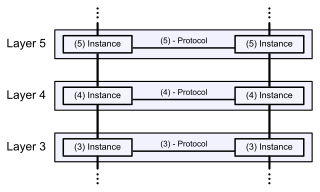The Internet protocol suite, commonly known as TCP/IP, is the set of communications protocols used in the Internet and similar computer networks. The current foundational protocols in the suite are the Transmission Control Protocol (TCP) and the Internet Protocol (IP).

The Open Systems Interconnection model, also known as the ISO/OSI reference model, is a conceptual model that describes the universal standard of communication functions of a telecommunication system or computing system, without any regard to the systems underlying internal structure and technology or specific protocol suite. Therefore, the objective is the interoperability of all diverse communication systems containing standard communication protocols for all networked communication.
Intermediate System to Intermediate System is a routing protocol designed to move information efficiently within a computer network, a group of physically connected computers or similar devices. It accomplishes this by determining the best route for data through a packet switching network.
Connectionless communication, often referred to as CL-mode communication, is a data transmission method used in packet switching networks in which each data unit is individually addressed and routed based on information carried in each unit, rather than in the setup information of a prearranged, fixed data channel as in connection-oriented communication.
A virtual circuit (VC) is a means of transporting data over a packet-switched network in such a way that it appears as though there is a dedicated physical link between the source and destination end systems of this data. The term virtual circuit is synonymous with virtual connection.

X.25 is an ITU-T standard protocol suite for packet-switched data communication in wide area networks (WAN). It was originally defined by the International Telegraph and Telephone Consultative Committee in a series of drafts and finalized in a publication known as The Orange Book in 1976.
In the seven-layer OSI model of computer networking, the network layer is layer 3. The network layer is responsible for packet forwarding including routing through intermediate routers.
Signalling System No. 7 (SS7) is a set of telephony signaling protocols developed in 1975, which is used to set up and tear down telephone calls in most parts of the world-wide public switched telephone network (PSTN). The protocol also performs number translation, local number portability, prepaid billing, Short Message Service (SMS), and other services.
In the seven-layer OSI model of computer networking, the session layer is layer 5.

In computer networking, the transport layer is a conceptual division of methods in the layered architecture of protocols in the network stack in the Internet protocol suite and the OSI model. The protocols of this layer provide end-to-end communication services for applications. It provides services such as connection-oriented communication, reliability, flow control, and multiplexing.
The Message Transfer Part (MTP) is part of the Signaling System 7 (SS7) used for communication in Public Switched Telephone Networks. MTP is responsible for reliable, unduplicated and in-sequence transport of SS7 messages between communication partners.
The Common Management Information Protocol (CMIP) is the OSI specified network management protocol.
The Open Systems Interconnection protocols are a family of information exchange standards developed jointly by the ISO and the ITU-T. The standardization process began in 1977.
Connection-Oriented Network Service (CONS) is one of the two Open Systems Interconnection (OSI) network layer protocols, the other being Connectionless-mode Network Service (CLNS). It is basically X.25, with a few adjustments.
The Signalling Connection Control Part (SCCP) is a network layer protocol that provides extended routing, flow control, segmentation, connection-orientation, and error correction facilities in Signaling System 7 telecommunications networks. SCCP relies on the services of MTP for basic routing and error detection.
DO-212 is a performance standard published by RTCA, Incorporated. It contains Minimum Operational Performance Standards (MOPS) for aircraft equipment required for the Automatic Dependent Surveillance (ADS) function. The supporting hardware can be a stand-alone ADS unit or alternatively, the ADS function may be installed within other on-board equipment.
A communication protocol is a system of rules that allows two or more entities of a communications system to transmit information via any kind of variation of a physical quantity. The protocol defines the rules, syntax, semantics and synchronization of communication and possible error recovery methods. Protocols may be implemented by hardware, software, or a combination of both.
Security service is a service, provided by a layer of communicating open systems, which ensures adequate security of the systems or of data transfers as defined by ITU-T X.800 Recommendation.
X.800 and ISO 7498-2 are technically aligned. This model is widely recognized
A long-running debate in computer science known as the Protocol Wars occurred from the 1970s to the 1990s when engineers, organizations and nations became polarized over the issue of which communication protocol would result in the best and most robust computer networks. This culminated in the Internet–OSI Standards War in the late 1980s and early 1990s, which was ultimately "won" by the Internet protocol suite ("TCP/IP") by the mid-1990s and has since resulted in most other protocols disappearing.


